 Overview
Overview
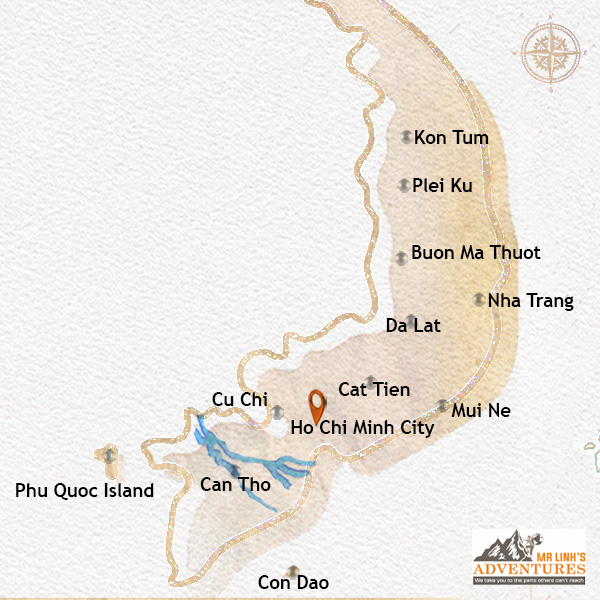 Ho Chi Minh City
Ho Chi Minh City, the bustling heart of Vietnam, pulses with a relentless energy that captivates every visitor. Formerly known as Saigon, this dynamic metropolis is a fascinating blend of old and new, where the echoes of its rich history resonate amidst the roar of modern development. Imagine a city where the hypnotic ballet of countless scooters weaves through streets lined with both elegant French colonial architecture and soaring skyscrapers, a testament to its rapid growth.
This is a city that never sleeps, a place where tradition and modernity collide, creating a unique and unforgettable Asian adventure.
 Top Attractions
Top Attractions

The statue of Ho Chi Minh in front of the city hall, today seat of the People’s Committee of HCM-City
Ho Chi Minh City, a bustling metropolis where history and modernity meet, offers a multitude of unforgettable experiences. To immerse yourself in the essence of this fascinating city, here are four must-see sites that will transport you through its tumultuous past, vibrant culture, and iconic architecture
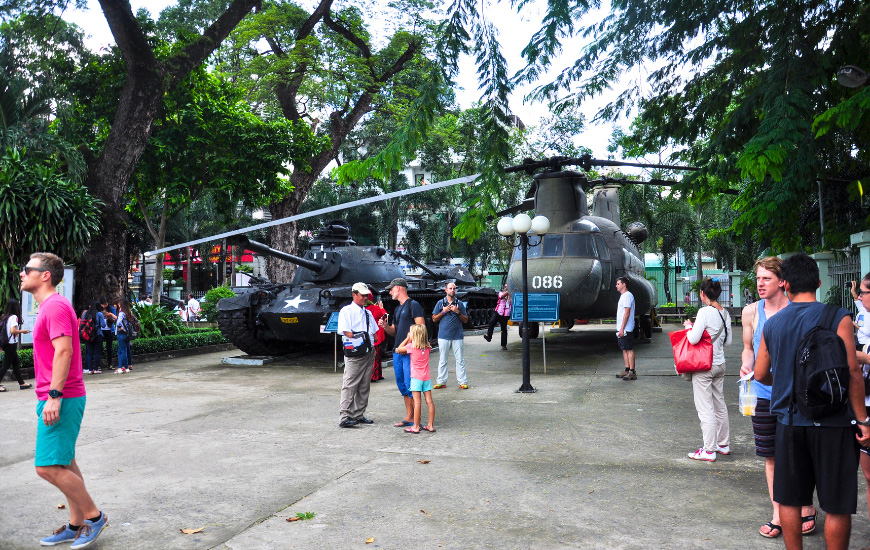 War Remnants Museum, a must-visit for history lovers - Mr Linh's Adventures
War Remnants Museum, a must-visit for history lovers - Mr Linh's AdventuresWar Remnants Museum
This poignant museum offers an uncompromising look at the Vietnam War, through photographs, artifacts, and moving testimonies. It is essential for understanding the country's contemporary history and the lasting consequences of the conflict.
 Notre Dame Cathedral of Saigon, a French colonial era heritage
Notre Dame Cathedral of Saigon, a French colonial era heritage Notre Dame Cathedral and Central Post Office of Saigon
These two architectural gems, legacies of the French colonial era, testify to the elegance and charm of yesteryear. The cathedral, with its neo-Romanesque style, and the central post office, with its Eiffel-style metal frame, are iconic symbols of the city.
Ben Thanh Market
Dive into the lively atmosphere of this century-old market, a veritable labyrinth of stalls where you'll find souvenirs, local products, and delicious street food. It's the perfect place to discover Vietnamese culture and haggle for some good deals.
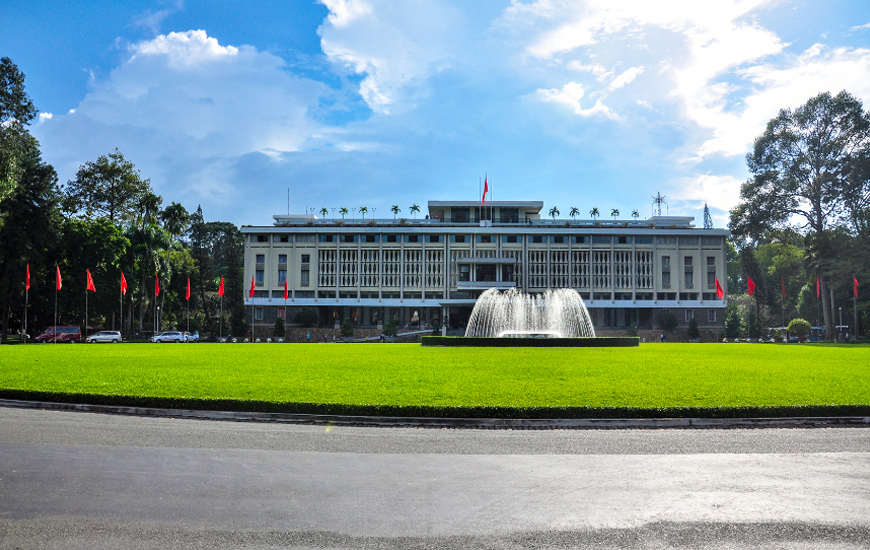 Reunification Palace, where Vietnam turned the page of history - Mr Linh's Adventures
Reunification Palace, where Vietnam turned the page of history - Mr Linh's AdventuresReunification Palace
This historic palace, formerly the Independence Palace, was the scene of crucial events in the Vietnam War. Explore its rooms and underground bunkers to relive the highlights of this period of history.
Cholon (Ho Chi Minh City's Chinatown)
Cholon is a world of its own, a lively and colorful Chinatown where you'll discover Buddhist and Taoist temples, bustling markets, and a unique atmosphere. It's a fascinating journey into the heart of Chinese culture in Vietnam.
 See & Do
See & Do
Buu Dien, the iconic Central Post Office of Saigon
Ho Chi Minh City is a city with a thousand facets, offering a multitude of activities for all tastes.
Strolling through iconic neighborhoods
The Place de la Commune-de-Paris, in the heart of Ho Chi Minh City, is an iconic spot where two architectural jewels stand side by side: the Central Post Office and Notre Dame Cathedral.
Notre Dame Cathedral, a masterpiece of neo-Romanesque style, was built between 1863 and 1880. Its two 58-meter-high steeples, topped with a cross, dominate the urban landscape and reflect the influence of French architecture. The building, still in use, is an important place of worship for the city's Catholic community.
Just opposite, the Central Post Office impresses with its architecture blending Gothic and Renaissance influences. Originally, the building designed by Gustave Eiffel was intended for the Telegraphic Service of Saigon. The post itself will replace the building in 1891, according to the plans of the architect Villedieu and his assistant Foulhoux. Inside, magnificent stained glass windows, pointed arches, and an elegant decor immerse visitors in an atmosphere of a bygone era. Two old maps, displayed in the building, trace the history of Saigon and the postal lines between Vietnam and Cambodia.
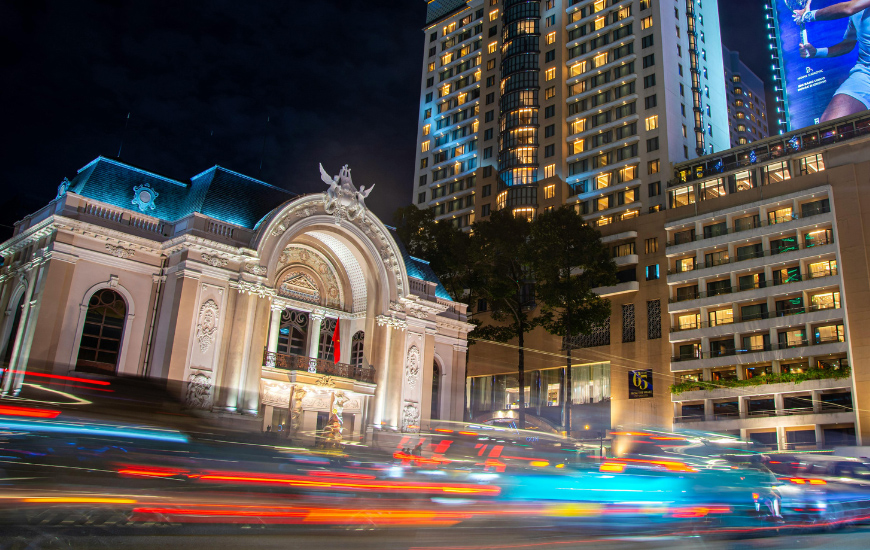
The Opera House reflects the French colonial architecture
Going up the street, towards the Saigon River, stands the imposing
Ho Chi Minh City Opera House. This majestic building, constructed at the beginning of the 20th century, reflects French colonial architecture.
Originally designed as an entertainment venue for French colonists, the theater has had several uses throughout its history. It notably served as the lower house of the Assembly of South Vietnam before being restored to its original function as a theater between 1975 and 1995.
Today, the Opera House is an important cultural venue that hosts a variety of shows: operas, ballets, symphony concerts, plays... Its stage has seen many Vietnamese and international artists perform, making this establishment a symbol of the city's cultural life. Its neoclassical style, its meticulous ornamentation, and its privileged location make it an essential place for art and history lovers.
Parallel to Dong Khoi,
Nguyen Hue is an emblematic thoroughfare of Ho Chi Minh City. Every weekend, the street is transformed into a pedestrian zone, offering a pleasant promenade, away from the hustle and bustle of traffic. Nguyen Hue provides access to the historic buildings of the Dong Khoi district and the quays of the Saigon River. It is a popular place for cultural events and gatherings.
Not far from there, the
Bitexco Tower (262.5 m) is another architectural curiosity of the city. Inspired by the lotus flower, emblem of Vietnam, this modern tower houses offices, shops, and leisure spaces. Its Skydeck and its lounge bar offer a breathtaking view of Ho Chi Minh City.
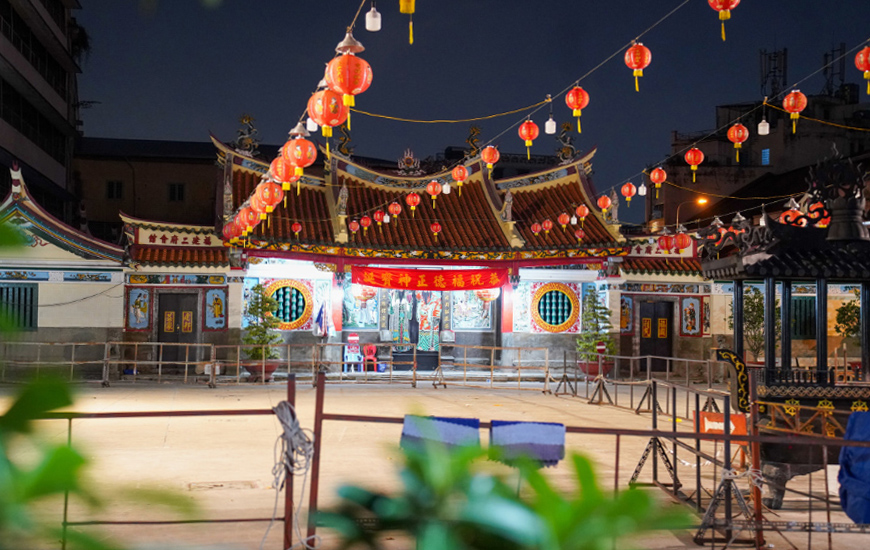
Discovering the Spirit of Saigon’s Chinatown - Mr Linh's Adventures
Cholon, also known as Chinatown, is a district of Ho Chi Minh City that has a unique culture and a rich history. It is one of the largest Chinese districts in the world in terms of area, with many interesting sites to visit.
Binh Tay Market is a very busy wholesale market where you can find all sorts of products: fruits, vegetables, fish, meat, clothes, shoes, etc. It is a lively and colorful place that allows you to discover the atmosphere of a typical Asian market.
Thien Hau Pagoda is an important place of worship for the Chinese community of Cholon. It is dedicated to the goddess of the sea, protector of sailors and merchants. The pagoda is adorned with numerous statues and sculptures, and there is a richly decorated altar.
Quan Am Pagoda is another important pagoda in Cholon. It is dedicated to the goddess of mercy, Quan Am. The pagoda is also richly decorated and houses many statues of Buddhist deities.
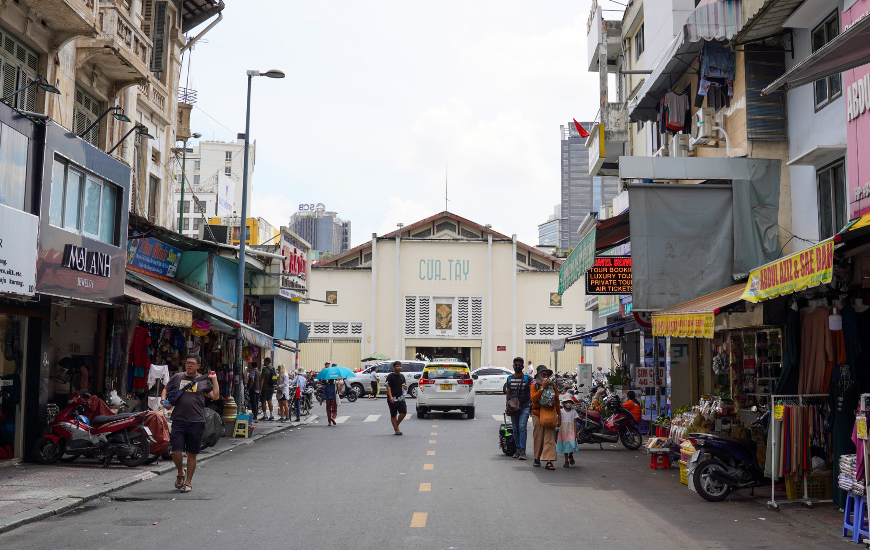 Iconic Ben Thanh Market - Mr Linh's Adventures
Iconic Ben Thanh Market - Mr Linh's Adventures
Ben Thanh Market is an emblematic place of Ho Chi Minh City, where you can immerse yourself in the local culture and discover the lively atmosphere of a traditional Vietnamese market.
This covered market, located in the heart of the city, is a real labyrinth of stalls where you can find all kinds of products. From local crafts to culinary specialties, including food products. The atmosphere of the market is unique, with its bright colors, its enchanting smells and its warm sellers who do not hesitate to negotiate prices.
Visiting museums
Ho Chi Minh City, booming, jealously preserves its history and that of Vietnam through its many museums. The Museum of Vietnamese History is a must for lovers of Indochinese history.
Located on the grounds of the botanical garden, in a green and peaceful setting, the museum offers a pleasant excursion. The museum's collections trace the history of Vietnam from prehistory, allowing visitors to discover the cultural evolution of the country through its various transformations.
The War Remnants Museum, located in the third district of Ho Chi Minh City, is an essential place of memory to understand the history of Vietnam and the tragedies of the war. The visit to the museum is an emotional shock. The exhibitions, often striking, testify to the atrocities and suffering endured by the Vietnamese people during the war.
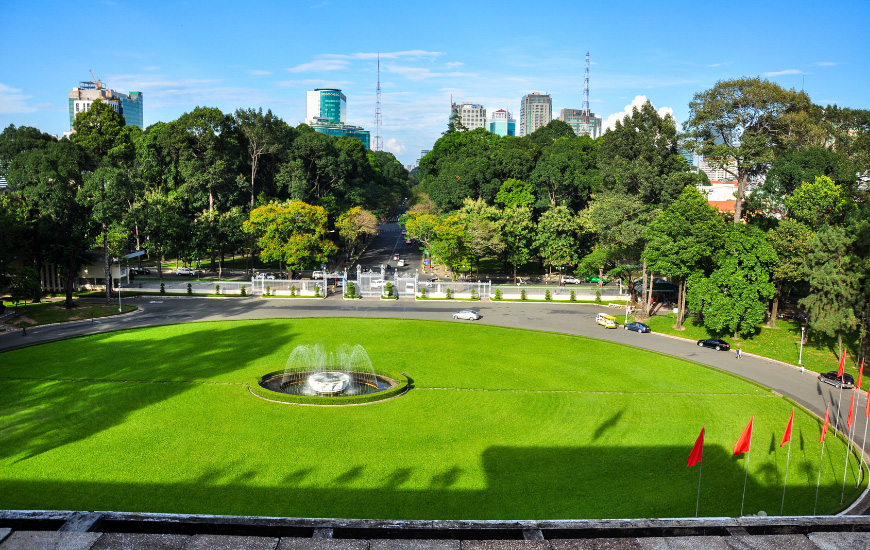 A Grand View from Reunification Palace - Mr Linh's Adventures
A Grand View from Reunification Palace - Mr Linh's AdventuresDiving into History
The Reunification Palace, located in District 1 of Ho Chi Minh City, is a place steeped in history that bears witness to key moments in Vietnam's history.
The aesthetics of the building reflect its important political role. It was here, in 1975, that the fall of Saigon and the end of the Vietnam War took place, with the capture of the palace by North Vietnamese tanks. An event that marked a turning point in the history of the country.
Today, the Reunification Palace is open to visitors. It houses reception and meeting rooms used for official events, as well as a basement housing former military headquarters and tunnels. The visit to the palace offers a unique glimpse into the history of Vietnam and allows a better understanding of the political and military issues of the time. One can notably imagine the strategic discussions that took place in the war rooms of the basement.
 Go Green
Go Green
For an unforgettable experience, Mr Linh's Adventure offers unique tours in the Ho Chi Minh City region. Discover fishing villages, explore rubber and pepper plantations, and meet local communities. Our passionate guides will share their love of the region and will make you experience authentic and emotional moments.
 Heritage
Heritage
Ho Chi Minh City, formerly known as Saigon, bears the traces of a tumultuous past. Its eventful history, marked by invasions and changes of sovereignty, makes it a city rich in contrasts.
It is fascinating to note that only a few centuries ago, this bustling metropolis was only a modest fishing village, called Prey Nokor, inhabited by the Khmer people. Over the centuries, the city has undergone several transformations. First attached to Cambodia, it came under Vietnamese domination in the 17th century, under the impetus of the Nguyen lords.
The city has known several political regimes, which explains the diversity of cultural and architectural influences. The French colonial era profoundly marked the city, giving it a European face that is still found today in certain buildings and in the local gastronomy.
Today, Ho Chi Minh City is a modern and dynamic metropolis, but its past remains present in memories and in the urban landscape. The colonial-style buildings, the traditional temples and the historic districts testify to the richness and complexity of its history.
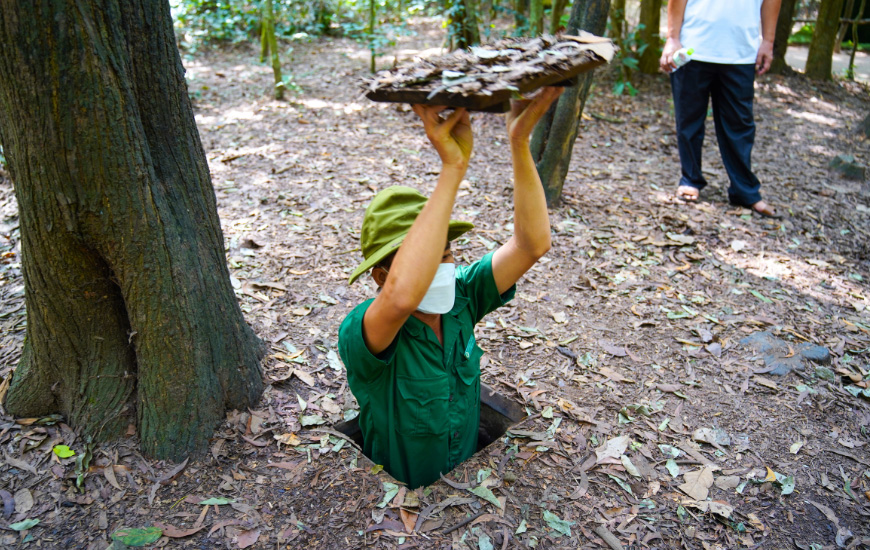 Cu Chi : Tunnel's entrance - Mr Linh's Adventures
Cu Chi : Tunnel's entrance - Mr Linh's AdventuresThe Cu Chi Tunnels
The Cu Chi Tunnels, located a few kilometers from Ho Chi Minh City, are an essential historical site to understand the history of Vietnam and the Vietnam War.
This vast network of underground tunnels, which stretched for hundreds of kilometers, was dug by the Vietnamese during the war to protect themselves from bombings and to carry out guerrilla actions.
The Cu Chi Tunnels played a crucial role in the Vietnamese resistance against the American forces. They served as a logistical base, shelter, communication point and headquarters for the Viet Cong soldiers.
Today, visitors can explore part of this impressive network and discover the difficult living conditions of the soldiers who lived and fought there.
The Jade Emperor Pagoda
Ho Chi Minh City is home to a mosaic of religions, with a predominance of Mahayana Buddhism, Taoism and Confucianism. The Jade Emperor Pagoda, located in District 1, is an emblematic place of worship that testifies to this diversity.
Built by the Chinese community in 1909, this pagoda is dedicated to both Buddhist and Taoist divinities, reflecting the religious syncretism of the region.
From the entrance, the visitor is enveloped by a cloud of incense smoke, which perfumes the air and creates a mystical atmosphere. The complex sculptures that adorn the pagoda testify to the know-how of local artisans. At the center of the main altar, the majestic statue of the Jade Emperor thrones, surrounded by his guards. The pagoda also houses other divinities, such as Kim Hua, goddess of fertility, and the sinister head of hell, with his assistants.
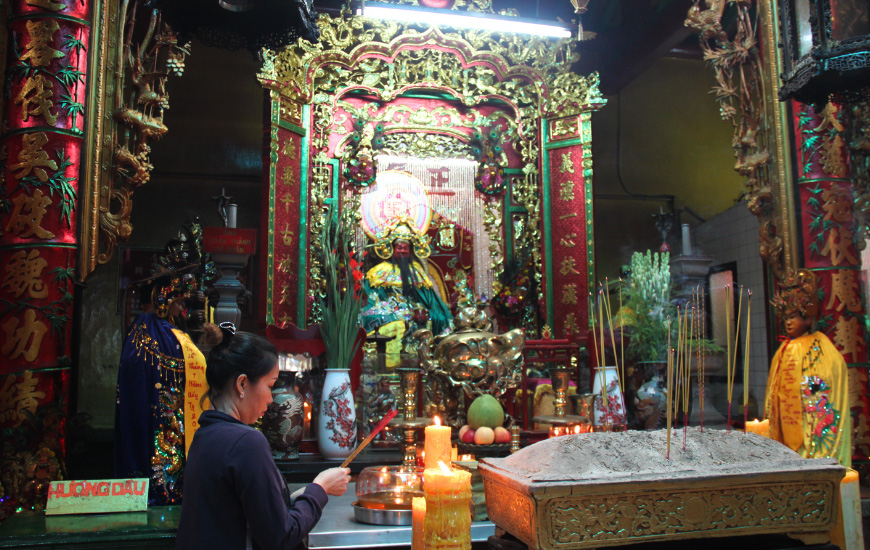 Phuoc An Hoi Quan Pagoda and its exuberant decoration
Phuoc An Hoi Quan Pagoda and its exuberant decorationPhuoc An Hoi Quan Pagoda
Located in District 5 of Ho Chi Minh City, the Phuoc An Hoi Quan Pagoda is a Buddhist place of worship that amazes with its exuberant architecture and decoration.
Upon entering the pagoda, the visitor is immediately struck by the intensity of the colors that adorn the walls: bright red, sparkling gold, emerald green and bright yellow create a warm and festive atmosphere. The ornamentation of the pagoda is just as remarkable, with spirals of incense hanging from the ceiling, traditional red lanterns and detailed sculptures that represent Buddhist divinities and scenes of daily life.
The pagoda is dedicated to Quan Cong, a deified Chinese general, whose statue sits behind the main altar.
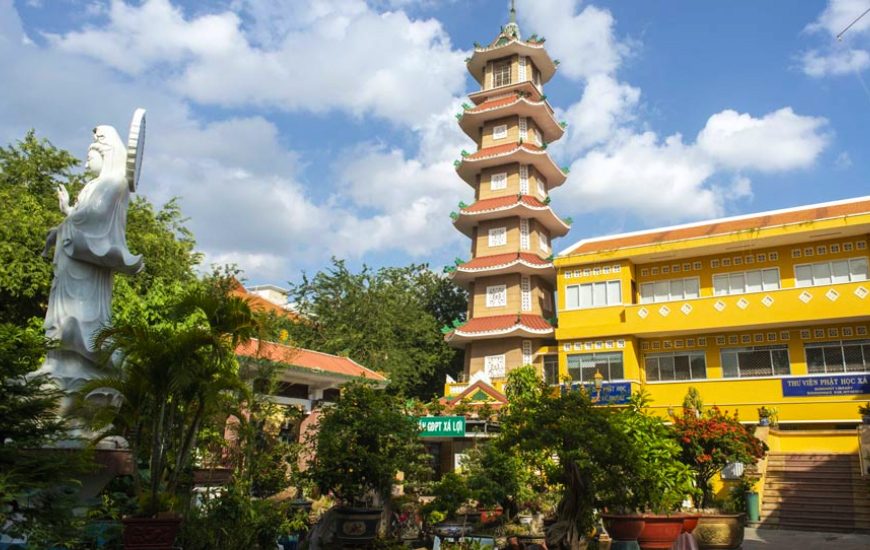 Serenity at Xa Loi Pagoda
Serenity at Xa Loi PagodaXa Loi Pagoda
The Xa Loi Pagoda, built in 1956, is the largest in Ho Chi Minh City. Formerly a high place of Buddhism in South Vietnam, it is best known for the tragic events that took place there in 1963, including raids and immolations of monks in protest against the Diem regime. Today, the pagoda is a peaceful place of worship where you can admire a large golden statue of Buddha in meditation.
Mariamman Temple
The Mariamman Temple, located in the center of Ho Chi Minh City, is a Hindu place of worship built at the end of the 19th century by Indian merchants. It is dedicated to Mariamman, the goddess of rain. The exterior of the temple is decorated with colorful sculptures representing various Hindu divinities. Inside, there is a statue of Mariamman and her guardians, to whom the faithful offer incense and flowers.
 Food & Drinks
Food & Drinks
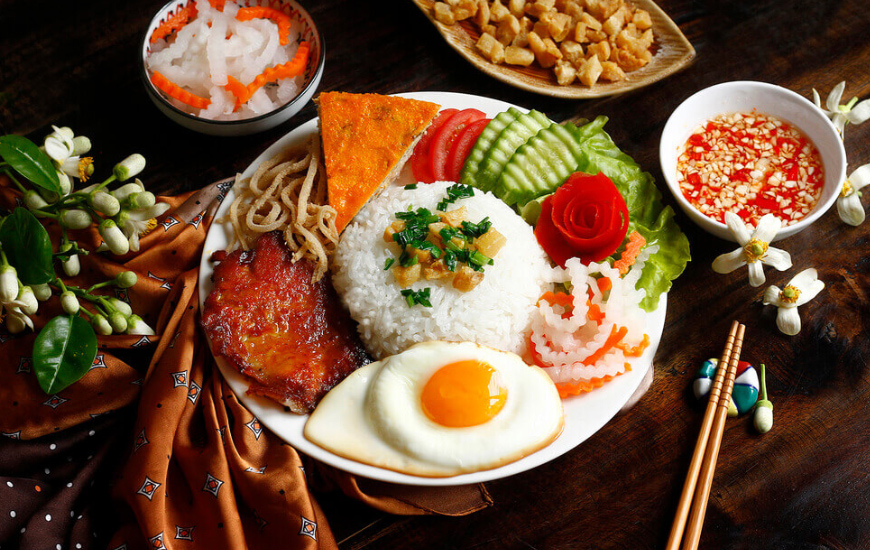 Cơm Tấm, A Must-Try Taste of Ho Chi Minh City - Mr Linh's Adventures
Cơm Tấm, A Must-Try Taste of Ho Chi Minh City - Mr Linh's Adventures
Ho Chi Minh City, a vibrant and multicultural metropolis, is a true paradise for food lovers. While Banh Xeo (savoury fried pancake) and Banh Khot (mini pancakes topped with shrimp) are must-try, the city is full of other culinary specialties that deserve to be discovered.
Com Tam
Among these taste treasures, com tam, or broken rice, occupies a special place. This dish, popular with locals, is simple, economical, and extremely tasty, often featuring grilled pork ribs, shredded pork skin, a steamed egg meatloaf called 'cha trung', and pickled vegetables, all served atop the uniquely textured broken rice grains.
Hu Tieu
A noodle soup of Chinese origin, offers a comforting warmth, often served with succulent seafood or tender pork in a flavorful, aromatic broth.
Bánh canh
Then there's bánh canh, a dish of thick, chewy noodles made from tapioca or rice flour, swimming in a rich broth and complemented by the delicate sweetness of crabs or other seafood.
Chè
To conclude a satisfying meal, or simply to indulge in a sweet treat, chè provides a delightful experience. This traditional Vietnamese dessert is a symphony of textures and flavors, consisting of a sweet mixture of ingredients such as creamy mung beans, refreshing fresh fruit, and the luscious richness of coconut milk.
Recommended areas for street food:
Co Giang Street: Known for its authentic dishes.
Ho Thi Ky Market: A paradise for local cuisine.
Nguyen Thuong Hien Street: Renowned for its seafood.
Su Van Hanh Street: A popular spot for Bánh xèo and other specialties.
 Directions
Directions
Location
Ho Chi Minh City is located in southern Vietnam.
How to get there
You can get there by plane from Hanoi or other cities in Vietnam. Ticket prices vary depending on the airline and the time of year.
Best time to visit
The best time to visit Ho Chi Minh City is from December to April, when it is dry and sunny.
Do not hesitate to
contact Mr Linh's Adventure to organize your trip to Ho Chi Minh City. We offer tailor-made tours adapted to your desires and your budget.